Abstract
In this study, we assessed the environmental impact of the remanufacturing of mining machinery components, by analyzing commonly used parts in a machine setup. No previous studies have conducted a detailed environmental impact assessment of any manufacturing processes for new or remanufactured components used in mining machinery. We analyzed the system boundaries and conducted inventory analysis to understand their function and determine their unit role in the machine. Then, we evaluated the environmental impacts of the manufacturing processes for the subparts and assy parts, along with the impact of logistic and remanufacturing processes. In particular, we assessed hydraulic equipment, which is a common component of mining machinery, and conducted a comparative assessment of the environmental impacts of new and remanufactured components. Our results indicated that the global warming potential (GWP) per mining machine throughout its lifecycle (LC) could be reduced by ~194 ton-CO2eq./LC. Assuming that the number of mining machinery in operation at a global scale is 571 machines (or units) per year, the GWP would be reduced by ~110,000 ton-CO2eq./year.
1. Introduction
More than 250 years have passed since the Industrial Revolution (late 18th century), and currently, human-made mass, especially from manufacturing units and construction, exceeds all living biomass [1]. There are growing concerns about global warming associated with an increase in the consumption of natural resources, owing to the mass consumption of mineral resources and an increase in greenhouse gas (GHG) emissions. Under these circumstances, the importance of a circular economy (CE) has been globally recognized, for developing a recycling-oriented society and achieving carbon neutrality, which is one of the prime Sustainable Development Goals (SDGs) adopted by the United Nations (UN) in 2015 [2]. Industries, governments, and businesses have contributed to achieve a recycling-oriented society. Remanufacturing, the goods from which have been categorized as “reused or recycled goods,” is effective in saving resources through the reuse of subparts and is more economically efficient than other means of recycling resources. Therefore, remanufacturing is used as a major means of achieving economic and environmental benefits.
The term “remanufacturing” refers to restoring a machine in operation on site, with its quality condition being nearly the same as that of a new machine and supplying it to the market. Notably, remanufacturing consists of collecting used components, disassembling and assembling, testing, and painting [3].
As shown in Figure 1, a wide variety of products are being remanufactured, and the remanufacturing market is growing exponentially, especially in recent times. Market research suggests that the remanufacturing market has a significant impact on various industries, with a market size of USD 43 billion in the United States of America (USA) (2011), USD 33 billion in Europe (2015), and USD 3.5 billion in China (2020). Notably, in the future, the remanufacturing business is expected to continue to grow globally [4,5,6]. An increasing number of studies on remanufacturing from the USA, Europe, and China reflect the growth of the remanufacturing market [7]. In the aerospace industry, because the quality of maintenance is directly related to service life and cost, which accounts for ~35% of the total market, the maintenance of each aircraft is strictly managed by not only manufacturers, but also airline companies (end-users) [8]. In the auto parts industry, which accounts for ~19% of the automotive market, there is a large market for remanufactured parts, owing to a high demand for auto parts, although the unit cost of parts is low [9].
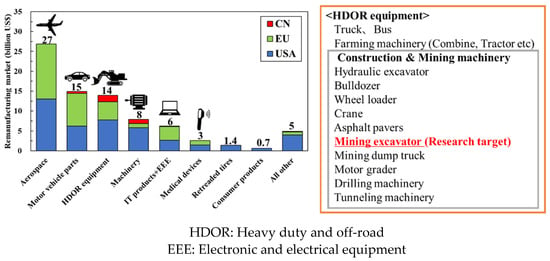
Figure 1.
Remanufacturing industries markets of each country. Research target is the mining excavator of HDOR equipment [4,5,6].
Commercial vehicles, such as buses and trucks, which are at the top of the remanufacturing market, are included in heavy-duty off-road (HDOR) equipment. In the construction and mining machinery industries, in which machinery is operated for ~24 h a day and 365 days a year, remanufactured parts are supplied from a logistic center near the construction site; this enables the quick replacement of parts on the site and reduces machine idle time. Therefore, there is a high demand for remanufactured parts. In particular, mining companies often use remanufactured parts throughout the process after cars are delivered from the first overhaul to scrapping. Remanufactured parts for mining machinery (mining shovels and trucks) accounted for a large share of the market, with an estimated market size of USD ~2 billion in 2015 [10].
There are many reports on the study and development of remanufacturing technology, with a focus on the process, demand forecasting, and machine and repair technology [3,11,12]. In the field of auto parts, environmental assessment studies have focused on the life cycle assessment (LCA) and economic assessment of remanufactured alternators and liquefied natural gas (LNG) and diesel engines [13,14]. Similarly, in the field of photocopiers and multifunction copiers, the LCA’s of remanufactured copiers have been conducted [15]. Owing to the difficulty in obtaining data, there are only a few studies on the environmental assessment of remanufacturing, with a focus on construction and mining machinery. Xiao et al. [16] assessed the future economic performance and an LCA for three cases: a machine mounted with remanufactured parts, a machine with parts remanufactured at the manufacturer’s factory, and a machine with parts remanufactured by a local dealer. They developed a hypothetical operational model in their assessment, and their LCA was only an estimate of the environmental impact of the manufacturing process only till the level of the production of materials, such as steel products, and was not an assessment of the detailed manufacturing process [16]. Jun et al. [17] conducted an LCA and estimated the environmental impact of the manufacturing process by multiplying the weight and material of each part of a hydraulic cylinder and reducer (=device) used in a construction machine and the replacement rate of the part by the characterization factor for the material. Additionally, previous studies have estimated the environmental impact of a construction machine by multiplying its estimated weight with the characterization factor of the material [17,18]. A study was conducted on the LCA of new construction and mining machines. Kwak et al. [19] calculated the global warming potential (GWP) of a wheel loader mounted with a Tier 4-certified diesel engine throughout its lifecycle, from material mining to end-of-life disposal. In addition to calculating the GWP during the service life of the machine, they performed a sensitivity analysis, while considering the differences in the load factor and fuel consumption of the engine, according to clients. The GWP during the service life of the machine accounted for ~80% of the GWP throughout the lifecycle, whereas the GWP in the maintenance process (remanufactured parts are not used) was estimated to be ~6% [19]. Using an LCA approach, Ebrahimi et al. [20] quantified the environmental impact of the engine and other components of a construction machine, which was compliant with European emission standards Stage V, at different stages of the lifecycle, from manufacturing to end-of-life disposal. They deduced that a cleaner alternative method was effective for treating end-of-life tires, owing to the tires’ very high freshwater aquatic ecotoxicity [20]. The abovementioned studies used the values estimated from the ecoinvent database, because foreground data, such as the electric power used in manufacturing, were not available.
The contribution and novelty of this study comprise a detailed environmental impact assessment of new and remanufactured components used in construction or mining machinery during the heat treatment and machining stages of the manufacturing process. As such, in this study, we assessed the environmental impact per machine of new and remanufactured components used in a mining machine by systematically examining the data obtained during the entire manufacturing process, from material refining to assembly, and in the remanufacturing process, during regular maintenance. In particular, the aim of our study was to portray the environmental impact of remanufacturing through quantitative assessments, with a focus on the hydraulic cylinder and reducer, which are heavy machines consisting of many constituting parts. Particularly, we evaluated the GWP of new and remanufactured components, based on data from an inventory analysis conducted during the new manufacturing and remanufacturing stages.
The organization of the rest of this article is as follows. Section 2 presents the research method, which includes descriptions of the target parts and function unit, system boundary, inventory analysis, and impact evaluation. Section 3 presents the results of the assessment, including the calculated environmental impact of the remanufacturing of each mining machine and a relative evaluation for the case of using a new one. Section 4 discusses the results and evaluates their potential environmental impact on a global scale. Finally, Section 5 gives a comprehensive conclusion and discusses potential next steps of the study.
2. Methods
In this study, we conducted an LCA in accordance with the standard ISO14040: 2006 (International Organization for Standardization) [21], the first international standard for LCA, established in 1997. More recently, ISO 14044: 2006 was established as a new standard in 2006 [22]. These two standards are defined and widely used as universal standard methods for LCA. Therefore, this study adopted them for the estimation of environmental impact.
2.1. Object and Evaluation Parts
2.1.1. Evaluation Parts
The components assessed in our study mainly included hydraulic equipment, such as the hydraulic cylinder, hydraulic pump, motor, and reducer. The Hitachi Construction Machinery’s EX2600 series was selected as the machine equipped with these parts [23]. Figure 2 portrays the configuration of the components used in the machine. Table 1 and Figure 3 illustrate the number and weight of the components used, and their usage rates by weight. Compared with other mining machines, the machine analyzed in our study was a highly versatile 250-ton-class model and had a relatively high usage rate. The assessed components consisted of ~3500 parts. Together, they weighed 25 tons and accounted for ~10% of the machine’s weight.
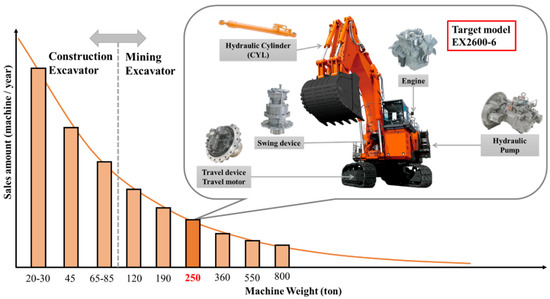
Figure 2.
Demand per machine weight and remanufacturing components of the hydraulic excavator. Target model is EX2600-6 [23].

Table 1.
Remanufacturing component and weight of one machine.

Figure 3.
Remanufacturing components and weight percentages.
Because each component was heavy and expensive, remanufacturing them was economically beneficial and expected to reduce environmental loads. Notably, the engine of the mining machines was not remanufactured and was, therefore, excluded from the assessment.
2.1.2. Function and Function Unit of Products
Each component of a mining machine is important for the smooth functioning of the machine. In this study, we used the service life (operating hours) of the mining machine as the function unit. Because the lifecycle of the mining machine from delivery to end-of-life disposal is ~60,000 h, an assessment was conducted, assuming that all the components would be replaced multiple times throughout the lifecycle (60,000 h). Generally, the replacement cycle is different for each component because the loading condition depends on the component. As shown in Table 1, the replacement cycle was averaged at 10,000 and 20,000 h, and we assumed that each component was replaced 3–6 times over the course of the machine service life.
In Scenario 1, we assumed that all the components were replaced with new components in the replacement cycle. In Scenario 2, we assumed that all the components were replaced with remanufactured components; for this case, we collected the data on the operation state of mining machines at mining sites worldwide and the reuse rate of components in the remanufacturing process. The accurate, detailed reuse rate of the subparts analyzed in our study could not be shown in this study because of confidentiality, but was ~50%.
2.1.3. System Boundary
Figure 4 portrays the system boundaries in the LCA of a machine. In this study, the processes inside the dotted frame were assessed. The new parts process (from material refining to the assembling, testing, painting, and distribution of parts) was assessed in all the scenarios. The remanufacturing parts process included washing, disassembly, and assessing the reusability of the part. As shown in Figure 3, we assessed in detail the following components: the hydraulic cylinder, reducer, hydraulic pump, and travel and swing motors. In the remanufacturing process, machining and surface treatment after material refining were considered as the key components of the machine in the assessment. Other components assessed included the rod and tube as components of the cylinder; the gear and carrier as components of the reducer; and the casing and cover as the key subparts of the hydraulic pump, travel, and swing motors.
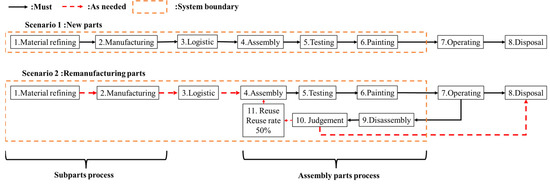
Figure 4.
System boundary.
The quality of the remanufactured components at the time of assessment was assumed to be the same as that of new components. In Figure 4, black arrows indicate the required processes. The red dotted-line arrows portray the processes that branch out, depending on the state of the subpart. The process up to the manufacturing of the subparts was performed at a plant in Japan. We considered a weighted average over the number of machines in operation, taking into account that the remanufacturing process was performed in three countries: Indonesia, Australia, and Zambia. The logistics process (from the manufacturing plant to the port in Japan) was the same for all the overseas plants and was, therefore, excluded from the system boundaries. However, we included the transport of parts from the port in Japan to an overseas remanufacturing plant in the logistic process. During the operating stage of the machine, the environmental load was similar for all scenarios; therefore, this factor was excluded from the assessment.
2.2. Inventory Analysis
For inventory analysis, we used IDEA ver. 2.02 to analyze the background data on raw materials required in the manufacturing and remanufacturing of the subparts and the energy exhausted [24]. We examined the process of the partner manufacturers, to obtain the foreground data, which was directly extracted to create a list of environmental loads. Figure 5 portrays the data collected at different stages. As the data of the yield in the manufacturing process of different components were not available, we estimated the yield based on the weight of the components shown in Figure 1. This process included smelting and material processing, such as casting, forging, surface treatment, machining, and heat treatment. We obtained the data on the consumption of power and LNG, liquefied petroleum gas (LPG), and chrome plating solutions during heat treatment, and distributed the data in proportion to the time used to manufacture the part. The metal debris generated during machining was excluded from the assessment because of the difficulty in obtaining the data. The foreground data of the casing and cover of the hydraulic pump and motor were not available directly, but the data of those of similar hydraulic pumps and motors were easily available. We estimated the yields based on the weight ratio, assuming that they were equivalent to those to be assessed. Furthermore, we assumed that the subparts would be carried by container ships from a port in Japan to an overseas port, and that in the case of Zambia, they would be carried by 2-ton trucks (the load being 50% of the loading capacity, on average) from the port in South Africa to the remanufacturing plant. The transport distance between the remanufacturing plant in Japan and the overseas plant was 6949 km for Indonesia, 7337 km for Australia, and 15,916 km (2108 km for transport by land) for Zambia. There are two types of assy parts: new and remanufactured parts. The inventory was estimated by considering the power consumption of the equipment, consumption of paint in the painting process, and the manufacturing time. We applied two cleaning processes to removing anti-rust oil and clean new parts. Generally, when a reused part is used in remanufacturing, cleaning time is reduced.
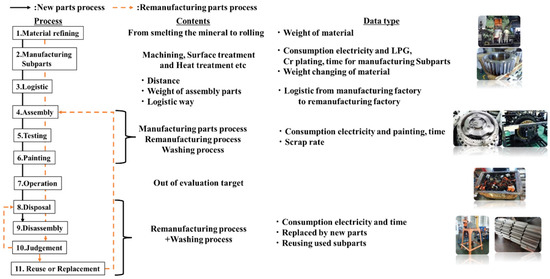
Figure 5.
Study target of foreground data.
2.3. Impact Evaluation
We used the 100a Data from the Intergovernmental Panel on Climate Change (IPCC) 2013 to calculate the characterization factor for GWP [25]. The factor was calculated while considering the effects of GHGs, such as carbon dioxide, methane, and dinitrogen monoxide. In this study, we evaluated the impact of these gases under the conditions specified in Section 3.1 and Section 3.2.
3. Results
3.1. Environmental Impact of the Manufacturing Process for Subparts
The manufacturing process of the subparts consists mainly of smelting, machining, and heat treatment. As shown in Figure 6a–d, we selected heavy parts of the machine as typical parts: cylinder rod and tube, reducer gear, and gear carrier. First, the GWP was generally the highest during the smelting process. Next, the GWP in the surface treatment processes, such as chrome plating and heat treatment, was 1674 kg-CO2eq./pcs for the boom cylinder rod and 537 kg-CO2eq./pcs for the travel reducer gear, owing to heat treatment (carburization, high-frequency hardening, and nitriding), portraying that these processes have a relatively high environmental load. A possible reason for the high GWP is that the equipment having large power consumption for plating, carburization, and nitriding is operated for a long period of time, and it consumes a large amount of chrome plating solutions, such as LPG and LNG. Notably, for the boom cylinder tube and travel reducer carrier, which do not require surface treatment, the GWP of the machining process occupies the next share of smelting.
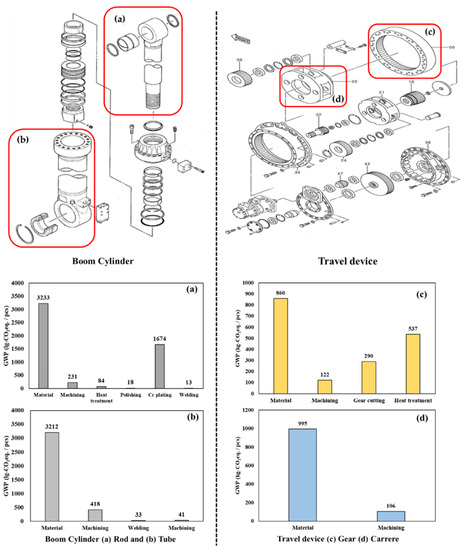
Figure 6.
GWP of the subparts process per component of the boom cylinder: (a) rod and (b) tube; and the travel device: (c) gear and (d) carrere.
The hydraulic pump was not a heavy part, but we assessed it for comparison purposes. Figure 7a–c portrays the estimates calculated by aggregating the GWPs of new and remanufactured subparts (including heavy parts, other than those described above) in the manufacturing process, from material smelting to welding and heat treatment. The GWPs in the material smelting process of the parts (the range indicated by the white arrow) tended to be the highest: (a) the GWP for the boom cylinder in the process, from smelting to welding, was ~9820 kg-CO2eq./pcs for the new subparts, and 6029 kg-CO2eq./pcs for the remanufactured ones; (b) the total GWP for the travel reducer was 9598 kg-CO2eq./pcs for new subparts in the process, from smelting to machining and heat treatment, and 4151 kg-CO2eq./pcs for remanufactured ones. Characteristically, these parts also have a high GWP; and (c) the total GWP for the hydraulic pump in the process, from smelting to machining and to heat treatment, was relatively low, with 1155 kg-CO2 eq./pcs for the new subparts, and 435 kg-CO2eq./pcs for the remanufactured ones.
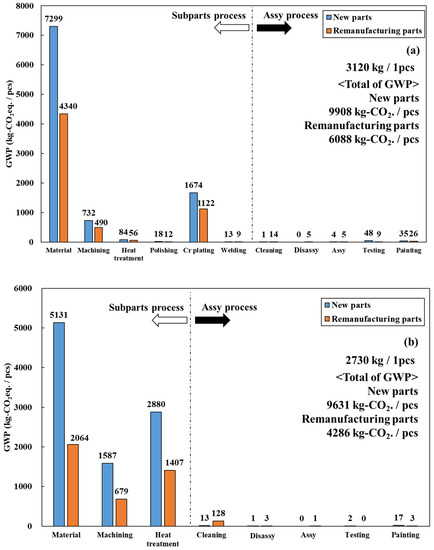

Figure 7.
GWP of the subparts and assy processes for the (a) boom cylinder, (b) travel device, and (c) hydraulic pump. (Disassy = Disassembly, Assy = Assembly).
These results suggest that in the manufacturing process of the subparts, product weight has a significant impact on the environment. A possible reason for this is that the weight increased in proportion to the processing time in each process.
All parts portrayed a high GWP in the smelting process because they were made mainly of cast iron or special steel and were thus, heavy, although they had a lower characterization factor than those made of mechanical structural carbon steel.
3.2. Environmental Impact of the Manufacturing Process for Assy Parts
The estimation of the GWP of subparts in the assembly stage of the manufacturing process of an assy part is shown in the range indicated by the black arrow in Figure 7a–c: (a) for the boom cylinder, which is a heavy part, cleaning and assembling accounted for a small share of the GWP. Notably, testing and painting accounted for 55% and 40%, respectively. Particularly, in the painting process, many large, long parts with a large surface area were painted, and thus, paint was used in large quantities, ~3 kg/pcs; (b) for the travel reducer, the GWP was generally low, because each process did not require equipment with high power consumption; and (c) for the hydraulic pump, the GWP in the testing process tended to be high, with 167 kg-CO2 eq./pcs for the new parts and 232 kg-CO2 eq./pcs for the remanufactured parts, despite them being relatively light weight. The main reason was that the testing process consumed a large amount of power. In the testing process, the hydraulic pump was tested by simulating the behavior of the engine when the machine was in operation. Therefore, the test required a high-power motor, control panel, and electric heater to heat the oil to a high temperature. The secondary reason for the high-power consumption was that the pump had more parameters that were tested, compared to the other parts, including low-load operation, resulting in a longer testing time. For the boom cylinder, the power output of the testing equipment was relatively low, and the test was completed in a short time. Therefore, the cylinder had a low GWP in the same testing process, with 48 kg-CO2 eq./pcs for the new parts and 9 kg-CO2 eq./pcs for remanufactured parts.
Each stage of the cleaning process was described as a distinctive feature. The remanufactured parts collected from the market had different appearances: some with dirt, sand, and paint removed, and some with a partially rusted surface. Therefore, it was important to clean the surface of the parts with a high-pressure water cleaner first and then, clean the inside of the parts in the assy state, after disassembly and before reassembly. Some parts could not be reused. In this case, the anti-rust oil was removed from the new parts (they must be cleaned). Because the cleaning process involved several stages, the number of subparts was directly linked to the level of GWP in the cleaning process.
For example, the GWP for the travel reducer in the cleaning process accounted for 76% of the GWP for all the processes. In this case, the number of subparts was 223 pcs/assy. In addition, because this was the same for the hydraulic pump in the cleaning process and many subparts were used in each assy part (346 pcs/assy), cleaning was the second highest in GWP, after testing. Because the number of subparts for the boom cylinder was 72 pcs/assy, which was relatively small compared to the other parts, the GWP was lower for the boom cylinder.
3.3. Environmental Impact of the Logistic Process
Figure 8 portrays shows the changes in GWP for different components in the logistic process. The GWP in the logistic process was estimated on a weight basis, suggesting that the GWP changed according to the weight of the component. In particular, a component with a high GWP was the hydraulic cylinder. Of all the components, the boom cylinder had the largest environmental load, and the GWP was estimated to be ~1275 kg-CO2eq./pcs. Notably, because the GWP in the logistics process of remanufactured parts depends on their reuse rate, the GWP values are reflected in the reuse rate.
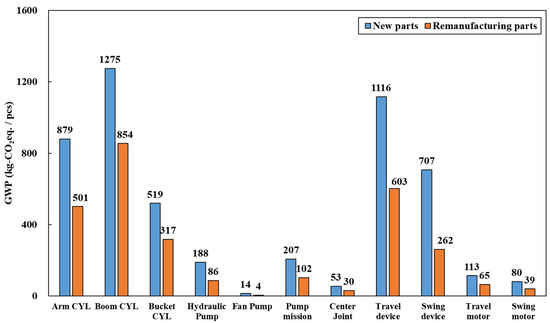
Figure 8.
GWP of the logistic process per component. (CYL = Cylinder).
3.4. Environmental Impact of the Remanufacturing Process
Figure 9 illustrates the GWP in the remanufacturing process (cleaning–disassembly–assembly–testing–painting) of individual components that are assembled into a machine in multiple quantities. Generally, as in the manufacturing process of new ones, the hydraulic pump and motor portrayed a high GWP, despite their low weight. Among the components assessed in this study, the hydraulic pump had the highest GWP of 726 kg-CO2eq./machine. As described in the previous section, this was largely due to the testing process, which accounted for ~90% of the GWP for all remanufacturing processes. Hydraulic travel and swing motors exhibited the same trend. This was probably because only one electric motor was used in the pump and motor testing, and a high-power motor was selected.
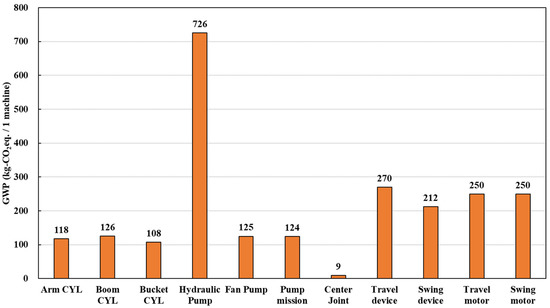
Figure 9.
GWP of the remanufacturing process per component. (Remanufacturing process = Cleaning, Disassembly, Assembly, Testing, Painting).
Among the other components, the boom cylinder had a GWP of 126 kg-CO2eq./machine during the remanufacturing stage and a GWP of 176 kg CO2eq./machine in the manufacturing stage. The difference in GWP between the new and remanufactured products was relatively small at ~50 kg-CO2eq./machine.
4. Discussion
4.1. Total Evaluation
Figure 10 illustrates the GWP per mining machine throughout its life cycle, which was comprehensively assessed, based on the results described above.
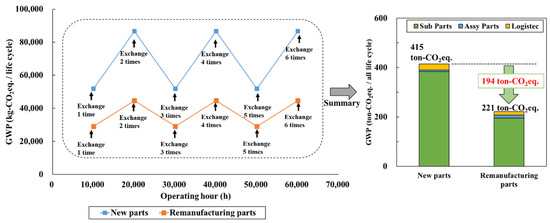
Figure 10.
GWP of new parts and remanufacturing parts per life cycle of one machine (EX2600-6).
It was assumed that the components (hydraulic cylinder and hydraulic pump) with a replacement cycle of 10,000 h would be replaced six times until disposal, and those (reducer and hydraulic motor) with a replacement cycle of 20,000 h would be replaced three times. However, because the components of a machine with an operating time of 0 h are in a new condition, the GWP was assumed to be the same for Scenario 1, where new components were replaced on a regular basis. For Scenario 2, wherein remanufactured components were replaced on a regular basis, they were excluded from the calculation. As a result, the total GWP of all the components was ~415 ton-CO2eq./LC in Scenario 1 and 221 ton-CO2eq./LC in Scenario 2. Thus, our results revealed that a total of 194 ton-CO2eq./LC can be reduced. The difference in GWPs between Scenarios 1 and 2 was 23 ton-CO2eq./cycle for a replacement cycle of 10,000 h and 42 ton-CO2eq./cycle for a replacement cycle of 20,000 h. This is because the material smelting process, which has a large environmental load, can be omitted; thus, significantly reducing the GWP of the remanufactured components. Notably, setting standards, along with the use of equipment and technology to ensure quality, are important for achieving this goal.
Based on the above results, we estimated the GWP for the mining machinery on a global scale, using the number of mining machines in operation [26]. In this report, the number of mining machines sold per year was estimated at 571 in 2020. From this number, with respect to Scenarios 1 and 2, the GWP was 240,000 ton-CO2eq./year in Scenario 1, wherein new components were used as replacements during the maintenance of a machine, and 130,000 ton-CO2eq./year in Scenario 2, wherein remanufactured components were used as replacements. Our calculations portray that the GWP can be reduced by ~110,000 ton-CO2eq./year in Scenario 2.
The results suggest that the reduction in environmental load of remanufacturing as described above is large. On the other hand, as a prospect of this research, the methodological approach could be made more reliable by considering the environmental impact assessment of other parts such as the engine, or for electrification, as de-carbonization becomes more common in both construction and mining machinery.
4.2. Effects of Green Manufacturing
Green manufacturing refers to energy and resource savings, as well as the control of harmful substances in the manufacturing process [27]. Therefore, regarding the manufacturing process of new and remanufacturing parts in this research, the process with the highest environmental load is material. That process is prominent. On the other hand, surface treatments such as heat treatment and chrome plating also show a high proportion (e.g., 20% for boom cylinder, and 30% for travel device (see in Figure 7a,b)). Regarding the assy process, there are concerns about increased power consumption in the pump test process and emission volatile organic compounds (VOCs), Propan-2-ol and Xylene using organic solvent paints [28] in the paint process. Therefore, there will be challenges to achieve power saving and facilitate the replacement of water-based paints [28] with lower VOC amounts in these processes, which are important for the overall assy process.
Particularly for the remanufacturing process, it is important to increase the reuse rate of components by developing machining, repair, and nondestructive testing technologies. Notably, increasing the reuse rate can significantly reduce the environmental load. The use of plating solutions and gases for surface treatment in the manufacturing of new subparts portrayed a higher impact on the environmental load than the consumption of power. Therefore, it is important for achieving a carbon-neutral society to more efficiently use plating solutions or switch to a new surface treatment having a lower environmental load. The environmental load of the cleaning process has been further reduced by developing and using a cleaning method [29]. In addition, if remanufacturing or direct reuse is not possible, a new value can be created by reusing the components among different industries, such as automotive lithium-ion batteries, catalysts, and smartphones, which can make a significant contribution to the circularity of resources [30,31,32].
4.3. Barrier Review
As described in the previous section, remanufacturing operations are known to have economic and environmental advantages but are not widely used in the industry. This is attributable to three factors: (1) issues related to collection and system, (2) technological issues, and (3) market issues [3,12,33,34].
In particular, concerning the collection and system-related issues, some countries have import restrictions on used items. Brazil, Argentina, and the Middle Eastern countries have provisions to ban the imports of retreads and used tires. Indonesia has strict import restrictions on core and remanufactured parts from other countries, including used parts. In particular, companies that develop an import business globally are required to have a license called an Angka Pengenal Importir Umum (API-U), in accordance with the Regulation of the Minister of Trade. However, the license cannot be used to import goods other than those listed in the Harmonized System Code (HS Code), for which a prior application has been made [35,36,37].
As described above, in some countries, import restrictions on scrapped and used parts apply to core and remanufactured parts, either because remanufactured parts are not well-recognized or to domestic industries. Therefore, there are unintended import restrictions on remanufactured parts. In these regions, one possible option is to operate a remanufacturing business on a local production and consumption basis, instead of catering to global business operations.
Notably, remanufacturers are classified into three types: original equipment manufacturers (OEM), contracted remanufacturers (CR), and independent remanufacturers (IR) [38]. Owing to local laws, many repair and rebuilding services provided by local CRs and IRs are available in these regions and compete against OEM.
5. Conclusions
In this study, we assessed the environmental impact of the new and remanufactured components commonly used in mining machines. We obtained highly reliable data by assessing the individual processes in detail. The major findings of this study are as follows:
- The GWP of a machine can be reduced by 194 ton-CO2eq./LC throughout its lifecycle per machine, using remanufactured components, instead of new ones. This is because the share of the manufacturing process of subparts decreased as the number of reused sub-parts increases, making a significant contribution to reducing the environmental loads. In addition, considering the number of mining machines in operation worldwide, the GWP can be reduced by ~110,000 ton-CO2eq./year.
- Of all the processes, the manufacturing process of the subparts portrayed the highest environmental impact. In particular, material smelting and surface treatment accounted for a large share of the GWP. For example, the GWP of a new boom cylinder rod was 3233 kg-CO2 eq./pcs during smelting. The environmental load of the surface treatment process was significantly affected by the consumption of chrome plating solutions. Hydraulic pumps and motors, which consume a large amount of power in the testing process, can be effective in reducing the GWP and can thus, be powered by renewable energy and energy-saving motors, so as to develop a quality assurance system for low-power motors.
- The cleaning process of the remanufactured components portrayed the largest environmental impact. This is because the outside and inside of the components must be cleaned before and after they are disassembled and reassembled. Thus, improving the efficiency of the cleaning process will further contribute to reducing the environmental load of remanufactured components.
Previous studies have not quantified the environmental impact of remanufactured components per mining machine. In our study, we conducted a highly reliable LCA of mining machine components by estimating the GWP of the components, while considering the data measured in the new manufacturing and remanufacturing stages, which have a large environmental load, with regional differences. As a result, this study clarified the lower environmental load which can be achieved by using remanufactured components.
The aim of this study was to assess new and remanufactured components commonly used in mining machinery manufactured by the OEM. By including rebuilt and reused components in the assessment, we expect a further comprehensive discussion of the environmental impact of remanufacturing. However, it is important to assume the replacement cycle and reuse rate of different components, owing to the differences in their quality.
Author Contributions
Conceptualization, T.K. and M.M.; methodology, T.K.; software, T.K. and K.T.; validation, T.K. and M.M.; formal analysis, T.K. and M.M.; investigation, T.K.; resources, T.K. and M.Y.; data curation, T.K. and M.Y.; writing—original draft preparation, T.K.; writing—review and editing, M.M.; visualization, T.K.; supervision, K.T.; project administration, T.K.; funding acquisition, M.Y. All authors have read and agreed to the published version of the manuscript.
Funding
This research received no external funding.
Informed Consent Statement
Not applicable.
Data Availability Statement
The data presented in this study are available on request from the corresponding author. The data are not publicly available due to restrictions of corporate data openness.
Acknowledgments
The authors are grateful to the following persons and companies for cooperating with the authors’ interviews and for providing the LCA foreground data: Hitachi Construction Machinery Australia Pty. Ltd.: Craig, S.; PT Hexindo Adiperkasa Tbk: Sukandar, S. Moh, D.; Hitachi Construction Machinery Zambia Co. Ltd.: Mushinko, A.; Hitachi Construction Machinery Co. Ltd.: Asaga, T., Sugimura, Y., Ooae, S., Hida. K., Komuro, K. and Ishida, S.
Conflicts of Interest
The authors declare no conflict of interest.
References
- Elhacham, E.; Ben-Uri, L.; Grozovski, J.; Bar-On, M.Y.; Milo, R. Global human-made mass exceeds all living biomass. Nature 2020, 588, 442–444. [Google Scholar] [CrossRef] [PubMed]
- United Nations. Available online: https://sustainabledevelopment.un.org/partnership/?p=573 (accessed on 15 February 2022).
- United Nations Environmental Programme. International Resource Panel (UNEP-IPR): Re-defining Value—The manufacturing revolution. Remanufacturing, Refurbishment, Repair and Direct Reuse in the Circular Economy. 2018. Available online: https://www.resourcepanel.org/reports/re-defining-value-manufacturing-revolution (accessed on 15 February 2022).
- United States International Trade Commission (USITC). Remanufactured Goods: An overview of the US and Global Industries, Markets, and Trade; United States International Trade Commission: Washington, DC, USA, 2013; Volume 332–525, pp. 2-1–2-11. [Google Scholar]
- Catherine, W. A Circular Economy Handbook for Business and Supply Chains; Kogan Page Limited: London, UK, 2017; pp. 310–312. [Google Scholar]
- Gao, J.; Chen, X.; Zhang, X.; Gao, Y.; Zhang, X.; Kumar, S. Overview of remanufacturing industry in China: Government policies, enterprise, and public awareness. J. Clean. Prod. 2020, 242, 1–17. [Google Scholar]
- Ngu, J.H.; Lee, D.M.; Osman, B.S.M. Review on current challenges and future opportunities in Malaysia sustainable manufacturing: Remanufacturing industries. J. Clean. Prod. 2020, 273, 1–13. [Google Scholar] [CrossRef]
- ARSA (Aeronautical Repair Station Association). Global MRO Market Economic Assessment; ICF SH&E: Fairfax, VA, USA, 2013; pp. 4–20. [Google Scholar]
- Matsumoto, M.; Chinen, K.; Endo, H. Remanufactured auto parts market in Japan: Historical review and factors affecting green purchasing behavior. J. Clean. Prod. 2018, 205, 1029–1041. [Google Scholar] [CrossRef]
- Accuray Research Co. Ltd. Global Mining Remanufacturing Components Market Analysis & Trends—Industry Forecast to 2027; Accuray Research: Noida, India, 2019; p. 28. [Google Scholar]
- GIS RIT: Technology Roadmap for Remanufacturing in the Circular Economy. 2017. Available online: https://www.rit.edu/sustainabilityinstitute/public/Reman_Roadmap_2017.pdf (accessed on 15 February 2022).
- Matsumoto, M.; Yang, S.; Martinsen, K.; Kainuma, Y. Trend and research challenges in remanufacturing. Int. J. Precis. Eng. Manuf. Green Technol. 2016, 3, 129–142. [Google Scholar] [CrossRef]
- Schau, E.; Traverso, M.; Finkbeiner, M. Life cycle costing in sustainability assessment—A case study of remanufactured alternators. J. Remanufacturing 2012, 5, 1–14. [Google Scholar] [CrossRef] [Green Version]
- Shi, J.; Li, T.; Liu, Z.; Zhang, H.; Jiang, Q. Comparative life cycle assessment of remanufactured liquefied natural gas and diesel engines in China. J. Clean. Prod. 2015, 101, 129–136. [Google Scholar] [CrossRef]
- Keer, W.R.C.; Ryan, C. Eco-efficiency gains from remanufacturing: A case study of photocopier remanufacturing at Fuji Xerox Australia. J. Clean. Prod. 2001, 9, 75–81. [Google Scholar] [CrossRef]
- Xiao, L.; Liu, W.; Guo, Q.; Gao, L.; Zhang, G.; Chen, X. Comparative life cycle assessment of manufactured and remanufactured loading machines in China. Resour. Conserv. Recycl. 2013, 131, 225–234. [Google Scholar] [CrossRef]
- Jun, Y.; Kang, H.; Jo, H.; Baek, C.; Kim, Y. Evaluation of environmental impact and benefits for remanufactured construction equipment parts using life cycle assessment. Procedia Manuf. 2019, 33, 288–295. [Google Scholar] [CrossRef]
- Jun, Y.; Jo, H.; Kim, Y.; Kang, H.; Hwang, Y.; Kim, Y. Analysis of potential economic and environmental effects through remanufacturing of construction equipment in Korea. Procedia Manuf. 2020, 43, 620–626. [Google Scholar] [CrossRef]
- Kwak, M.; Kim, L.; Sarvana, O.; Kim, M.H.; Finamore, P.; Hazewinkel, H. Life cycle assessment of complex heavy-duty equipment. Proc. ASME 2012, 7180, 1–11. [Google Scholar]
- Ebrahimi, B.; Wallbaum, H.; Jakobsen, D.P.; Booto, K.G. Regionalized environmental impacts of construction machinery. Int. J. Life Cycle Assess. 2020, 25, 1472–1485. [Google Scholar] [CrossRef]
- ISO14040 (International Organization for Standardization). Available online: https://www.iso.org/standard/37456.html (accessed on 10 January 2022).
- ISO14044 (International Organization for Standardization). Available online: https://www.iso.org/standard/38498.html (accessed on 20 June 2022).
- Hitachi Construction Machinery Co., Ltd. Available online: https://japan.hitachi-kenki.co.jp/files/1591-product_large_excavators_EX2600-6.pdf (accessed on 10 January 2022).
- IDEA (Inventory Database for Environmental Analysis). IDEA Ver 2.02. Available online: http://idea-lca.com (accessed on 10 January 2022).
- IPCC (Intergovernmental Panel on Climate Change). IPCC Forth Assessment Report. Climate Change 2007, IPCC. Available online: https://archive.ipcc.ch/publications_and_data/ar4/wg1/en/tssts-2-5.html#table-ts-2 (accessed on 10 January 2022).
- Singh, H.; Kochhar, K. Mining Machinery Market—Global Forecast to 2025; Markets and Markets: Northbrook, IL, USA, 2020; pp. 78–79. [Google Scholar]
- Paul, I.D.; Bhole, G.P.; Chaudhari, J.R. A review on green manufacturing: It’s important, methodology and its application. Procedia Mater. Sci. 2014, 6, 1644–1649. [Google Scholar] [CrossRef] [Green Version]
- Oguzcan, S.; Rande, A.; Dvarioniené, J.; Kruppiené, J. Comparative life cycle assessment of water based and solvent-based primer paints for steel plate priming. J. Environ. Res. Eng. Manag. 2016, 72, 83–96. [Google Scholar] [CrossRef] [Green Version]
- Muthukumar, C. A short review on alternative cleaning methods to remove scale and oxide from the jet engine alloys. Int. J. Eng. Tech. Res. 2015, 4, 10. [Google Scholar]
- Zink, T.; Maker, F.; Geyer, R.; Amirthajah, R.; Akella, V. Comparative life cycle assessment of smartphone reuse: Repurposing vs. refurbishment. Int. J. Life Cycle Assess. 2014, 19, 1099–1109. [Google Scholar] [CrossRef]
- Nikkei Asia. Available online: https://asia.nikkei.com/Business/Automobiles/Toyota-to-recycle-hybrid-and-EV-batteries-for-renewable-energy-use (accessed on 6 February 2022).
- Yoshimura, A.; Tochigi, S.; Matsuno, Y. Fundamental study of palladium recycling using “Dry Aqua Regia” considering the recovery from spent auto-catalyst. J. Sust. Metal. 2021, 7, 266–276. [Google Scholar] [CrossRef]
- Kanazawa, T.; Hayakawa, M.; Beltran, D.; Yoshimoto, M.; Saito, K.; Maruyama, Y.; Uchiyama, M.; Sasaki, T. Nondestructive testing of friction-fatigued carburized martensite steel. Mater. Trans. 2021, 62, 135–138. [Google Scholar] [CrossRef]
- Kanazawa, T.; Hayakawa, M.; Yoshimoto, M.; Tahara, Y.; Hata, N.; Meguro, S.; Hiroto, T.; Matsushita, Y.; Sugawara, M. Damage evaluation of carburizing gear remanufacturing. Mater. Trans. 2021, 62, 1660–1668. [Google Scholar] [CrossRef]
- Kojima, M. Remanufacturing and trade regulation. Procedia CIRP 2017, 61, 641–644. [Google Scholar] [CrossRef]
- Ministry of Finance. Available online: https://www.beacukai.go.id/websitenewV2/index.html (accessed on 10 January 2022).
- Matsumoto, M.; Chinen, K.; Jamaludin, R.; Yusoff, M.S.B. Barriers for remanufacturing business in Southeast Asia: The role of governments in circular economy. In EcoDesign and Sustainability I; Kishita, Y., Matsumoto, M., Inoue, M., Fukushige, S., Eds.; Springer Nature, Singapore Pte Ltd.: Singapore, 2021; pp. 151–161. [Google Scholar]
- Sundin, E.; Sakao, T.; Lindahl, M.; Kao, C.-C.; Joungerious, B. Map of Remanufacturing Business Model Landscape. ERN 2016, 11, 16–17. [Google Scholar]
Publisher’s Note: MDPI stays neutral with regard to jurisdictional claims in published maps and institutional affiliations. |
© 2022 by the authors. Licensee MDPI, Basel, Switzerland. This article is an open access article distributed under the terms and conditions of the Creative Commons Attribution (CC BY) license (https://creativecommons.org/licenses/by/4.0/).